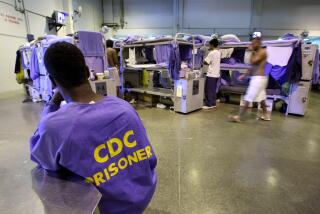Meth Users Lead Diversion Statistics
- Share via
In the first independent evaluation of a state measure diverting nonviolent drug offenders to treatment rather than prison, UCLA researchers found that methamphetamine abusers and whites comprised the largest portions of the 30,000 people sent to rehabilitation during the first year of Proposition 36.
Of the drug offenders diverted to treatment in 2001 under the proposition, 50% were methamphetamine abusers. Cocaine users were a distant second, at 15%; 12% were marijuana users; and 11% heroin users, according to the state-commissioned study released today by UCLA’s Integrated Substance Abuse Programs. Also, about 50% of the drug offenders sent to treatment were white, 31% Latino and 14% African American, the study found.
Those numbers, however, contrast sharply with the ethnic background of those incarcerated for drug offenses in California; Latinos and African Americans made up more than 68% of the people sent to state prisons on drug charges last year, according to state statistics.
The report, which is the first of a series studying the impact of Proposition 36, did not try to determine the causes of any ethnic disparity. Douglas Longshore, a behavioral scientist at UCLA and lead researcher for the report, said more data would be necessary before any such analysis could be done.
Proposition 36, which California voters approved in November 2000, permits first- and second-time, nonviolent offenders convicted of simple drug possession to receive substance abuse treatment instead of incarceration.
Judges are given some leeway in deciding who is eligible for the program. The state has allocated $120 million annually for 5 1/2 years to pay for treatment services.
The fact that whites seem to be benefiting more from Proposition 36 than other ethnic groups is a cause for concern, said Whitney Taylor, director of Proposition 36 implementation for the Drug Policy Alliance, a national organization that argued for the measure’s passage.
Heavier policing in black and Latino communities probably leads to higher numbers of arrests and convictions there, ultimately giving more of those drug offenders criminal records that make them ineligible for the program, she said.
“I don’t think it’s a problem with [the proposition]; I think it’s a problem with the criminal justice system,” Taylor said.
Dan MacAllair, executive director of the Center on Juvenile and Criminal Justice, an organization devoted to reducing the nation’s emphasis on incarceration, suggested that whites might have more access to better legal representation.
“There are questions that need to be answered,” he said. “I would want to look at arrest and charging patterns. Is it an economic crime in certain communities as opposed to a user crime in white communities? We need to be collecting the data.”
The statistics on methamphetamine abusers in treatment under Proposition 36 showed how widespread abuse of that drug became in the past decade, said Longshore of UCLA.
“For several years now, the meth epidemic has been very real in California,” he said. “Starting in the mid-1990s, the number of meth users in treatment really skyrocketed here.”
Counties have not yet compiled statistics on the success rate of Proposition 36 treatment programs. But the report found that streamlining services at the local level increased the rate of treatment. Also, the use of courts devoted solely to drug cases bolstered participation in treatment.
UCLA researchers did not release a county-by-county breakdown of the data. But Los Angeles County officials said the profile of local Proposition 36 participants differed somewhat from the rest of the state, with somewhat less methamphetamine abuse than the state average.
Methamphetamine was still the most commonly used drug, with 29.3% of offenders in Los Angeles County in 2001 listing that as their primary drug of choice, according to the county Department of Health Services. That was followed closely by cocaine, 29%; alcohol, 8.9%; and heroin, 7.6% of diversion program participants.
In Los Angeles County, the biggest percentage of offenders diverted to treatment were Latino, 38.5%. African Americans and whites each make up 28.9% of participants and Asians 1.7%.
After the program’s first year, Los Angeles County officials recommended additional services for clients who speak only Spanish, women with children, and people diagnosed with both substance abuse and mental health problems, according to Carol Morris Lowe. She is planning director for the Alcohol and Drug Services Administration in the county Department of Health Services.
The county Board of Supervisors recently approved 29 new contracts to expand services to these populations.
More to Read
Sign up for Essential California
The most important California stories and recommendations in your inbox every morning.
You may occasionally receive promotional content from the Los Angeles Times.










